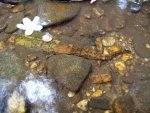wes_von_papineäu
Our Roving Correspondent
- Joined
- Apr 21, 2006
- Messages
- 494
- Reaction score
- 10
- Points
- 0
- Location
- Vancouver, British Columbia
- Country
- Canada
- Display Name
- Wes von Papineäu
INSIDE UF (University of Florida, Gainesville) 02 July 07 Ozark salamander collecting a factor in population drop, study finds
Gainesville, Fla.: An endangered “giant” Ozark salamander is suffering an alarming population collapse, and a new Florida Museum of Natural History-led study shows illegal collecting, mostly attributed to the pet trade, contributed to the decline of these imperiled amphibians that can grow to 29 inches in length.
The hellbender salamander (Cryptobranchus alleganiensis bishopi) study by Florida Museum Herpetology Curator Max Nickerson and Jeffrey Briggler of the Missouri Department of Conservation is published in the summer issue of the journal Applied Herpetology. St. Louis Zoo’s WildCare Institute and the Reptile and Amphibian Conservation Corps provided funding.
Nickerson and Briggler reviewed literature including population surveys from 1969 to 1989 to determine possible collecting effects on the salamanders, which can live 30 to 35 years in the wild.
“In 1969, when we first started studying the Ozark site on the North Fork of Missouri’s White River, hellbenders were common,” Nickerson said. “Today they are rare and face possible extinction.”
The population decline of amphibians has alarmed and puzzled scientists for decades. Nickerson said evidence of the hellbender salamander decline during the 1980s was attributed to numerous possible factors, including collecting or flooding, but little or no scientific data was provided.
Nickerson and Briggler reviewed literature from a 14.6-kilometer stretch of the North Fork and determined that 558 total salamanders were removed between 1969 and 1989 for both scientific and illegal collecting. Within that stretch lies a smaller, 2.67-kilometer study site which contains an important riffle (riffle 2-3) where the most dense known Ozark hellbender population once lived. Nickerson and Briggler state that 271 hellbenders were collected illegally from this study section between 1969 and 1989, and of those, 256 were taken during a period of major illegal collecting.
“Of those 256 individuals, 156 were removed for the pet trade during a single weekend: Labor Day weekend in 1980,” Nickerson said. “Another 15 were removed the same weekend, but we don’t have evidence that these were removed for the pet trade.”
Scientific studies accounted for the collection of 272 individuals between 1969-1989, which were removed from a 10-kilometer area external but adjacent to the 2.67-kilometer study site. Nickerson said that a lack of population estimates for this area makes it difficult to determine the impact from scientific collecting.
Nickerson’s paper states that his 1969 survey of the 2.67-kilometer section yielded an average of 428 hellbenders per kilometer whereas surveys for the same study area in 2005 and 2006 yielded only four hellbenders total.
“It’s very likely additional hellbenders have been taken illegally,” Nickerson said. “But the documented illegal collecting between 1980 and 1984 essentially eliminated the densest population of Ozark hellbenders known.”
Illegal collecting was aided by the construction of public access facilities adjacent to riffle 2-3, he said, and scientific literature cites the location.
“The synergistic effects of both scientific and illegal collecting clearly has been a factor in the decline of the Ozark hellbender populations, a decline that was documented as beginning by 1980,” Nickerson said.
Nickerson currently is researching the effects of scientific collecting on the hellbender population decline.
http://insideuf.ufl.edu/2007/07/02/ozark-salamander/
Gainesville, Fla.: An endangered “giant” Ozark salamander is suffering an alarming population collapse, and a new Florida Museum of Natural History-led study shows illegal collecting, mostly attributed to the pet trade, contributed to the decline of these imperiled amphibians that can grow to 29 inches in length.
The hellbender salamander (Cryptobranchus alleganiensis bishopi) study by Florida Museum Herpetology Curator Max Nickerson and Jeffrey Briggler of the Missouri Department of Conservation is published in the summer issue of the journal Applied Herpetology. St. Louis Zoo’s WildCare Institute and the Reptile and Amphibian Conservation Corps provided funding.
Nickerson and Briggler reviewed literature including population surveys from 1969 to 1989 to determine possible collecting effects on the salamanders, which can live 30 to 35 years in the wild.
“In 1969, when we first started studying the Ozark site on the North Fork of Missouri’s White River, hellbenders were common,” Nickerson said. “Today they are rare and face possible extinction.”
The population decline of amphibians has alarmed and puzzled scientists for decades. Nickerson said evidence of the hellbender salamander decline during the 1980s was attributed to numerous possible factors, including collecting or flooding, but little or no scientific data was provided.
Nickerson and Briggler reviewed literature from a 14.6-kilometer stretch of the North Fork and determined that 558 total salamanders were removed between 1969 and 1989 for both scientific and illegal collecting. Within that stretch lies a smaller, 2.67-kilometer study site which contains an important riffle (riffle 2-3) where the most dense known Ozark hellbender population once lived. Nickerson and Briggler state that 271 hellbenders were collected illegally from this study section between 1969 and 1989, and of those, 256 were taken during a period of major illegal collecting.
“Of those 256 individuals, 156 were removed for the pet trade during a single weekend: Labor Day weekend in 1980,” Nickerson said. “Another 15 were removed the same weekend, but we don’t have evidence that these were removed for the pet trade.”
Scientific studies accounted for the collection of 272 individuals between 1969-1989, which were removed from a 10-kilometer area external but adjacent to the 2.67-kilometer study site. Nickerson said that a lack of population estimates for this area makes it difficult to determine the impact from scientific collecting.
Nickerson’s paper states that his 1969 survey of the 2.67-kilometer section yielded an average of 428 hellbenders per kilometer whereas surveys for the same study area in 2005 and 2006 yielded only four hellbenders total.
“It’s very likely additional hellbenders have been taken illegally,” Nickerson said. “But the documented illegal collecting between 1980 and 1984 essentially eliminated the densest population of Ozark hellbenders known.”
Illegal collecting was aided by the construction of public access facilities adjacent to riffle 2-3, he said, and scientific literature cites the location.
“The synergistic effects of both scientific and illegal collecting clearly has been a factor in the decline of the Ozark hellbender populations, a decline that was documented as beginning by 1980,” Nickerson said.
Nickerson currently is researching the effects of scientific collecting on the hellbender population decline.
http://insideuf.ufl.edu/2007/07/02/ozark-salamander/



